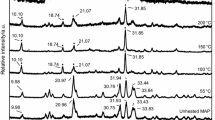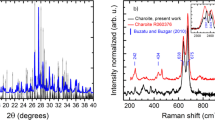Summary
The mineral metatorbernite, Cu[(UO<Subscript>2</Subscript>)<Subscript>2</Subscript>(PO<Subscript>4</Subscript>)]<Subscript>2</Subscript>·8H<Subscript>2</Subscript>O, has been studied using a combination of energy dispersive X-ray analysis, X-ray diffraction, dynamic and controlled rate thermal analysis techniques. X-ray diffraction shows that the starting material in the thermal decomposition is metatorbernite and the product of the thermal treatment is copper uranyl phosphate. Three steps are observed for the dehydration of metatorbernite. These occur at 138°C with the loss of 1.5 moles of water, 155°C with the loss of 4.5 moles of water, 291°C with the loss of an additional 2 moles of water. These mass losses result in the formation of four phases namely meta(II)torbernite, meta(III)torbernite, meta(IV)torbernite and anhydrous hydrogen uranium copper pyrophosphate. The use of a combination of dynamic and controlled rate thermal analysis techniques enabled a definitive study of the thermal decomposition of metatorbernite. While the temperature ranges and the mass losses vary from author to author due to the different experimental conditions, the results of the CRTA analysis should be considered as standard data due to the quasi-equilibrium nature of the thermal decomposition process.
Similar content being viewed by others
Author information
Authors and Affiliations
Rights and permissions
About this article
Cite this article
Horváth, E. Thermal decomposition of metatorbernite - a controlled rate thermal analysis study. J Therm Anal Calorim 79, 721–725 (2005). https://doi.org/10.1007/s10973-005-0602-0
Issue Date:
DOI: https://doi.org/10.1007/s10973-005-0602-0




